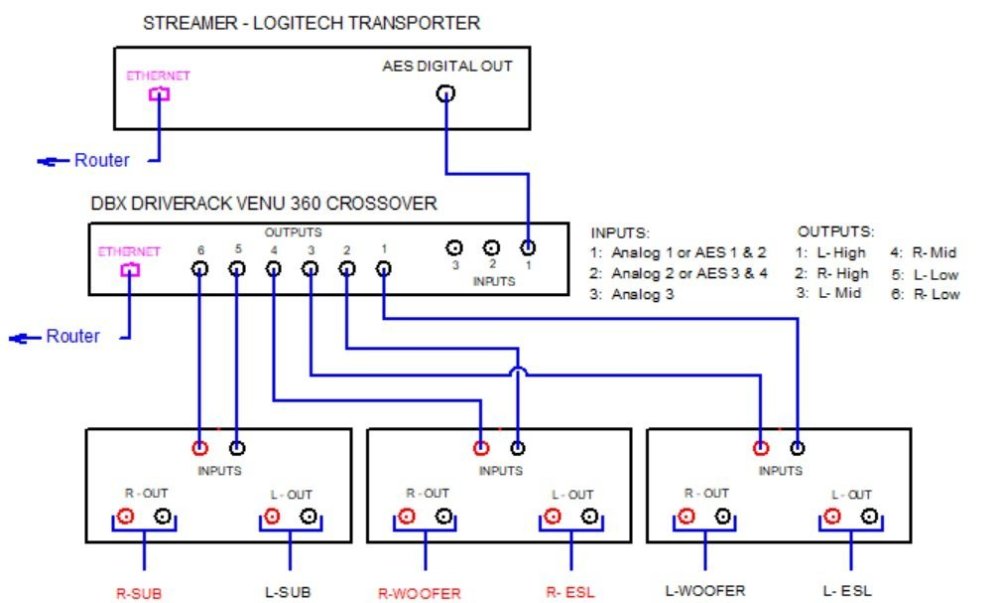Trn335
Member
Some background: over my 25 years of ML SL3 ownership I've had numerous configurations in several systems; amps, preamps, speakers, sources, etc. I rebuilt the SL3's a few years ago (new panels and caps) even though I used them only infrequently my systems but, I know they can sound really good in the right setting. Last year I had a new house built with a large, open area (18x40x10) and thought this might be a good situation to bring the SL3's bout of semi-retirement as I now had the space to play with them in the room.
Upon moving in to the new place, I set up the system with a modded Oppo BDP105D, a custom turntable, and a Primaluna Dialogue Integrated with phono pre. I listened to this setup for 4-5 months or so. But it wasn't really 'it' - lots of re-positioning, room treatments, experimentation - not bad but not great. I recalled a configuration from many years ago where I drove the SL3's with a Pass Labs X150 direct from a Wadia CDP and I remembered it as really engaging. I no longer had the Wadia but the Oppo can also act as a pre so I pulled the Pass out of my studio system and replaced the Primaluna. The effect was immediately noticeable and the improvement felt to me as mostly power-related, better dynamics, fuller across the spectrum. The Primaluna had sounded like it was working hard to drive the speakers enough to fill the room whereas the Pass didn't seem to strain. But, I kinda like tubes.
This led me to pick up a Schiit Freya+ pre as it would allow me to get tubes in the signal path (or not, because the Freya can operate in three modes: passive, SS buffered, or tube; it gave me options). Aside: oddly enough, I've found I prefer passive mode on the Freya and have listened to it that way exclusively. I added a Schiit Urd transport and Benchmark Dac3 and removed the Oppo from the system. Not any great change here, neither better nor worse, just one more component to turn on, mostly. Not really surprising as the Oppo is a pretty good implementation of a delta-sigma dac, like the Benchmark.
Over the years, I've driven the SL3's with all manner of amps; Krell, Levinson, Acurus, Carver/Sunfire, Yamaha, and others I can't recall. But, if you have tried a Pass amp driving e-stats, you probably already know there seems to be some synergy there. I don't know why, there just is. Which is why I still have the Pass and all the other amps are long gone. And that brings me to the point of this post (finally, you might rightfully say).
About two months ago, I came across another Pass X150 at an attractive price. I thought, what the heck. It's a great-sounding amp and you can never have too many great-sounding amps, right? As the post title says, I decided to try vertically bi-amping the SL3's with the pair of Pass amps (does that make them 'stereoblocks'?) My reasoning for vertical instead of horizontal was to keep cable runs as short as possible.
I did not expect the results. What the...?!? Stunning. I mean, an instant, jaw-dropping difference. More. Of everything. Detail, air, authority, finesse, soundstage, presence, scale, realism, yada, yada, all the buzzwords...wow, a 'live' performance in the living room. For example, I had a pair of Rythmik L12 subs supplementing the speakers previously - I had to tune them out, essentially. They're basically plant stands now.
I'm an engineer (and musician). The engineer wants badly to understand what happened here. The musician is in revelry.
Upon moving in to the new place, I set up the system with a modded Oppo BDP105D, a custom turntable, and a Primaluna Dialogue Integrated with phono pre. I listened to this setup for 4-5 months or so. But it wasn't really 'it' - lots of re-positioning, room treatments, experimentation - not bad but not great. I recalled a configuration from many years ago where I drove the SL3's with a Pass Labs X150 direct from a Wadia CDP and I remembered it as really engaging. I no longer had the Wadia but the Oppo can also act as a pre so I pulled the Pass out of my studio system and replaced the Primaluna. The effect was immediately noticeable and the improvement felt to me as mostly power-related, better dynamics, fuller across the spectrum. The Primaluna had sounded like it was working hard to drive the speakers enough to fill the room whereas the Pass didn't seem to strain. But, I kinda like tubes.
This led me to pick up a Schiit Freya+ pre as it would allow me to get tubes in the signal path (or not, because the Freya can operate in three modes: passive, SS buffered, or tube; it gave me options). Aside: oddly enough, I've found I prefer passive mode on the Freya and have listened to it that way exclusively. I added a Schiit Urd transport and Benchmark Dac3 and removed the Oppo from the system. Not any great change here, neither better nor worse, just one more component to turn on, mostly. Not really surprising as the Oppo is a pretty good implementation of a delta-sigma dac, like the Benchmark.
Over the years, I've driven the SL3's with all manner of amps; Krell, Levinson, Acurus, Carver/Sunfire, Yamaha, and others I can't recall. But, if you have tried a Pass amp driving e-stats, you probably already know there seems to be some synergy there. I don't know why, there just is. Which is why I still have the Pass and all the other amps are long gone. And that brings me to the point of this post (finally, you might rightfully say).
About two months ago, I came across another Pass X150 at an attractive price. I thought, what the heck. It's a great-sounding amp and you can never have too many great-sounding amps, right? As the post title says, I decided to try vertically bi-amping the SL3's with the pair of Pass amps (does that make them 'stereoblocks'?) My reasoning for vertical instead of horizontal was to keep cable runs as short as possible.
I did not expect the results. What the...?!? Stunning. I mean, an instant, jaw-dropping difference. More. Of everything. Detail, air, authority, finesse, soundstage, presence, scale, realism, yada, yada, all the buzzwords...wow, a 'live' performance in the living room. For example, I had a pair of Rythmik L12 subs supplementing the speakers previously - I had to tune them out, essentially. They're basically plant stands now.
I'm an engineer (and musician). The engineer wants badly to understand what happened here. The musician is in revelry.








